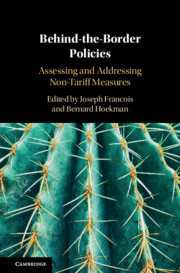Book contents
- Behind-the-Border Policies
- Behind-the-Border Policies
- Copyright page
- Contents
- Figures
- Tables
- Boxes
- Contributors
- 1 Moving beyond the Border
- Part I Concepts and Measurement
- Part II Assessing and Benchmarking Policy
- Part III Dealing with Non-tariff Measures: Legal and Institutional Contexts
- 8 Nontariff Measures Reforms
- 9 Good Regulatory Practices and International Trade
- 10 Rules of Origin as Non-tariff Measures
- 11 Behind-the-Border Measures and the New Generation of Trade Agreements
- 12 Nontariff Responses to China’s Development Strategy
- 13 A Time for Action
- References
- Index
12 - Nontariff Responses to China’s Development Strategy
The WTO’s Interface Challenge*
from Part III - Dealing with Non-tariff Measures: Legal and Institutional Contexts
Published online by Cambridge University Press: 25 October 2019
- Behind-the-Border Policies
- Behind-the-Border Policies
- Copyright page
- Contents
- Figures
- Tables
- Boxes
- Contributors
- 1 Moving beyond the Border
- Part I Concepts and Measurement
- Part II Assessing and Benchmarking Policy
- Part III Dealing with Non-tariff Measures: Legal and Institutional Contexts
- 8 Nontariff Measures Reforms
- 9 Good Regulatory Practices and International Trade
- 10 Rules of Origin as Non-tariff Measures
- 11 Behind-the-Border Measures and the New Generation of Trade Agreements
- 12 Nontariff Responses to China’s Development Strategy
- 13 A Time for Action
- References
- Index
Summary
China’s accession to the World Trade Organization (WTO) in 2001 came after lengthy negotiations. China’s exporters were granted nondiscriminatory tariff treatment by what are now more than 160 other WTO member countries. For its part, China agreed to carry out numerous steps to open itself to global trade and investment markets. In return for its agreement to abide by certain rules that normally govern a market economy, China was led to believe that trading partners like the United States would officially revoke its nonmarket economy (NME) status in December 2016. For China, the practical consideration of such a step was that its exporters would stop facing a special type of trade restriction.
- Type
- Chapter
- Information
- Behind-the-Border PoliciesAssessing and Addressing Non-Tariff Measures, pp. 277 - 298Publisher: Cambridge University PressPrint publication year: 2019

